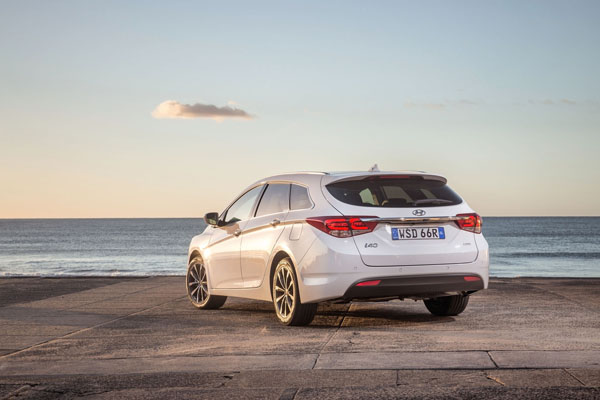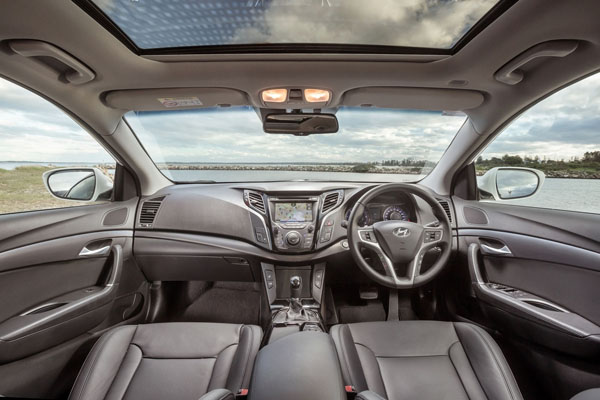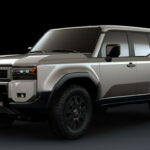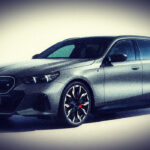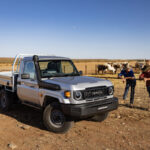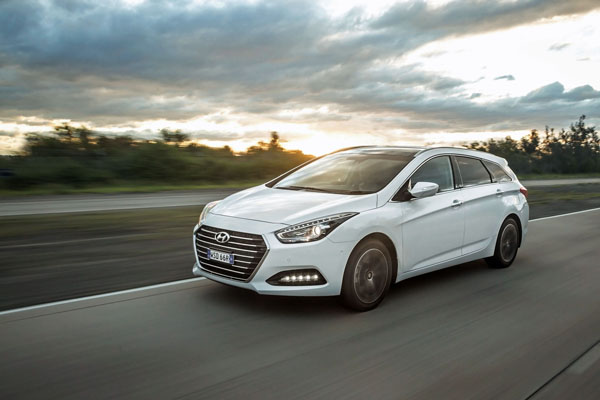
The popular Hyundai mid-size twins, the i40 Sedan and Tourer, have had a mid-life spruce-up and it’s much more than a once-over with a damp face cloth. Not only have the pair smartened up, they have a few new technological tricks up their sleeve.
Hyundai Series II i40 comes in sedan or Tourer (station wagon) form, with the choice of either petrol or diesel power and in a couple of specification levels – Active and Premium.
We tried out the Hyundai i40 1.7-litre CRDi turbo-diesel automatic Active Tourer, which comes to market at $35,090, plus on-road costs.
STYLING
Resemblance to the Series I is there, but the Series II features are sharper – from the more aggressive grille and projector-beam headlights, plus LED daytime running lights to stylish new taillights.
The grille has the family features of the i40’s cousin, the Veloster coupe, with its matte-black horizontal slats and contrasting chrome inserts. Chrome also adds a touch of class to the U-shaped surround.
The front bumper has been reshaped and all variants have redesigned wheels, the twin-spoke 16-inch alloys on i40 Series II Active are finished in silver.
The cabin has a convenient rear armrest storage box with a flip-up cover now adding to clever storage options for rear-seat passengers.
INFOTAINMENT
The infotainment screen is the focus of important interior upgrades. The Series I dot matrix audio has been replaced with a new 4.3-inch touchscreen making things easier for the user and giving the cabin more modern styling.
In addition to the existing AM/FM radio, CD-player, USB/AUX inputs and MP3 compatibility, the upgraded system now chips in with digital iPod connectivity (previously analogue), as well as a sophisticated media ripping / storage facility.
ENGINES / TRANSMISSIONS
The i40 Series II range is available with either Hyundai’s 2.0 GDi petrol engine (Tourer variants only), or 1.7 CRDi diesel (all variants).
For the i40 Series II, the diesel engine now combines with Hyundai’s all-new seven-speed dual-clutch automatic, replacing the six-speed automatic previously found in diesel-engined i40s.
Power output has increased from 100 kW to 104 kW at 4000rpm, while peak torque has jumped from 320Nm to 340Nm, from 1750 to 2500rpm.
SAFETY
Nine airbags – driver and front passenger, driver and front passenger side (thorax), rear outboard side (thorax), full-length curtains, and driver’s knee – are augmented by Electronic Stability Control, including Traction Control System, ABS brakes with Electronic Brake-force Distribution, Brake Assist System, Vehicle Stability Management.
Automatic dusk-sensing headlights, LED daytime running lights and emergency stop signal keep the vehicle in clear view of other road users.
Parking is aided by front and rear proximity alarms, plus a rear-view camera, both of which are bonuses with a vehicle approaching five metres in length.
DRIVING
Following other recent Series II upgrades in Hyundai’s passenger vehicle and SUV line-up, i40 Series II has adopted more advanced 32-bit motor-driven power steering, replacing the previous 16-bit system. Steering feedback to the driver was the winner here.
Hyundai’s highly regarded Australian chassis development team revisited the i40’s suspension, ride and handling by matching the new steering system with various combinations of springs, dampers and stabiliser bars.
Thirty separate suspension combinations were exhaustively tested, both on the road and via computer modelling. The results are impressive, giving the Tourer the ability to deal with the quite challenging surfaces, including those with mid-corner bumps, of country roads.
I could not match Hyundai’s diesel Tourer fuel consumption claim of 5.1 litres per 100 kilometres, but still clocking a respectable 5.4 litres per 100 kilometres during highway cruising and a far-from unfriendly 7.6 litres per 100 in town. The latter wasn’t helped by having much of the maximum 1672 litres (rear seat back folded) cargo space taken up with gear.
SUMMING UP
For those who can get over the current obsession with owning a mid-size two-wheel drive SUV with their inherent obesity and lack of cargo capacity, the Hyundai i40 turbo-diesel Active Tourer could be the answer.
AT A GLANCE
MODEL LINE-UP
i40 1.7 CRDi diesel 7sp DCT Active sedan $33,090
i40 1.7 CRDi diesel 7sp DCT Premium sedan $41,990
i40 2.0 GDi petrol 6sp auto Active Tourer $32,490
i40 2.0 GDi petrol 6sp auto Premium Tourer $41,390
i40 1.7 CRDi diesel 7sp DCT Active Tourer $35,090
i40 1.7 CRDi diesel 7sp DCT Premium Tourer $43,990
Note: These prices do not include dealer or government charges. Contact your local Hyundai dealer for drive-away prices.
FEATURES (Active)
9 airbags (driver & front passenger, driver & front passenger side (thorax), rear outboard side (thorax), full-length curtains, driver’s knee)
Electronic Stability Control including Traction Control System, Anti-lock Braking System, Electronic Brake-force Distribution, Brake Assist System, Vehicle Stability Management
Automatic dusk-sensing headlights
Emergency Stop Signal
LED Daytime Running Lights
Hill-start Assist Control
Front and rear parking assist system
Rear-view camera
16-inch alloy wheels with 205/60 R16 tyres
Keyless entry with burglar alarm
4.3-inch touchscreen audio system with CD player, MP3 capability, 6 speakers, media ripping/storage
AUX/USB audio input with digital iPod compatibility
Bluetooth connectivity (hands-free phone & audio streaming)
Steering wheel-mounted audio and phone controls
Cruise control with steering wheel-mounted controls and speed-limiter function
Electronic Park Brake
Front and rear power windows with one-touch window up/down function on driver’s window
Heated exterior mirrors
Height-adjustable driver’s seat
One-touch turn signal operation
Premium gear knob and steering wheel
Steering wheel-mounted paddle shifts
Tilt and telescopic steering column
Trip computer
LED high-mount stop light
Cargo blind and safety barrier net (Tourer)
Roof rails (Tourer)
SPECIFICATIONS:
(1.7-litre four-cylinder turbo-diesel engine)
Capacity: 1685 cc
Configuration: 16-valves, DOHC, CRDi common-rail turbocharged diesel engine
Bore and stroke: 77.2 mm x 90.0 mm
Compression ratio: 15.7:1
Maximum Power: 104 kW @ 4000 rpm
Maximum Torque: 340 Nm @ 1750-2500 rpm
DRIVELINE:
Drivetrain: Seven-speed dual clutch
DIMENSIONS, WEIGHT AND CAPACITIES:
Length: 4775 mm
Width: 1815 mm
Height: 1470 mm
Wheelbase: 2770 mm
Track: 1591 mm (front); 1597 mm (rear) Active
Ground clearance: 140 mm
Kerb weight: 1539 kg / 1692 kg
Gross vehicle mass: 2150 kg
Towing capacity: 1500 kg (braked) / 700 kg (unbraked)
Tow ball download: 180 kg
Seating capacity: 5
Cargo capacity 506 litres (rear seat back up); 1672 litres (rear seat back folded)
Fuel Tank Capacity: 70 litres
Turning circle: 10.94 m
SUSPENSION AND BRAKES:
Suspension: MacPherson strut with Amplitude Selective Dampers (front); Multi-link with Amplitude Selective Dampers (rear)
Brakes: 300 mm x 28 mm ventilated disc (Active) (front); 284 mm x 10 mm solid disc (Active) (rear). Dual-diagonal, split circuit, power assisted with Electronic Brakeforce Distribution and Brake Assist. Vehicle Stability Management. Hill Start Assist
Steering: Motor Driven Power Steering, rack & pinion
Wheels / tyres: Alloy 16 x 7.0J alloy wheels with 205/60R16 tyres Full-size spare
PERFORMANCE
Acceleration 0 to 100 km/h: N/A
Top speed: N/A
FUEL CONSUMPTION:
Fuel type: Diesel
Combined Cycle (ADR 81/01): 5.1 litres per 100 km. CO2 emissions 134 g / km
GREEN VEHICLE GUIDE RATINGS:
Greenhouse Rating: 8.0 / 10
Air Pollution Rating: 6.0 / 10
WARRANTY:
Five years / unlimited kilometres




